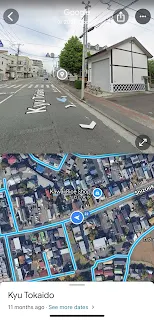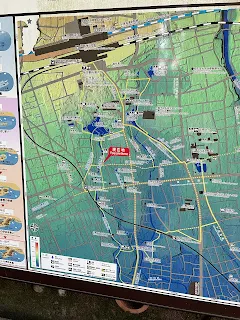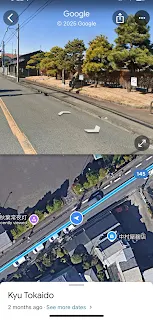三島宿(Mishima inn town): an inn town with abundance of spring water
Alright, finally we are approaching Mishima inn town.
Before entering Mishima inn town, there is a rock to tie your horse while paying a visit to Hokyoin temple, which is literally 2 blocks down from here. line.
I went to Mishima several times including western part of Tokaido Mishima inn town.
Today, Edo-time houses are very scarce, and lots of 1950-1980’s houses and buildings are standing.
Mishima Taisha shrine is one of the most famous attractions in Mishima. It is a very ancient shrine that we don’t know when it was established. Including this shrine, there are a lot of natural water spring in Mishima and its neighboring towns, coming from Mt.Fuji and Mt.Hakone.
Mishima city website says that upper water supplied to each household in this city comes from natural water springs and wells. (The picture on the right taken by me in 2023)
Old houses stand sporadically, but Tokaido in downtown Mishima preserves more atmosphere of 1980s for most part. By the way, the old houses on the right side of the picture is an eel restaurant.
Mishima had 2 honjins. One of them was Seko Honjin. This is what former Seko Honjin site looks like today.
And there is a small bridge over Genbei River. It was built by Genbei Terao in 26th century. However, many websites also say that it was originally built in 8th century as an irrigation canal.
Today, the water is crystal clear, and there is a path by and on the water to enjoy. (I will write on a separate topic)
The next two pictures show 千貫樋(Sengandoi) aqueduct. Originally built in 15th century, and during Edo period with lumbar, this was destroyed during 1923 Great Kanto Earthquake. It was rebuilt with concrete. This aqueduct supplies water from Kohamagaike pond, south of today’s JR Mishima station inside Rakujuen Japanese garden, to neighboring towns for rice fields.
The term Sengan means 1,000 kan(a unit to describe large amount of gold), and the origin of the name of the aqueduct has is said to be 1) the technology was worth with lots of money, 2) construction costed a lot, 3) the amount of harvested rice due to this aqueduct is worth with lots of money. We don’t know which one is true.
And this is the end of Mishima inn town.
Going a bit further, there is an interesting spot. I found this spot on our way back from Kakitagawa water park in Shimizu town. There are a couple of old houses to show what this route used to look like, then look at the next picture down on the left.
There are pine trees. On top of it, there is 常夜灯(Joyato), an all-night street lamp. This was at a different location originally then relocated to where it is today. Joyato was common in inn towns, seaports etc.
Going a bit further, there is an interesting spot. I found this spot on our way back from Kakitagawa water park in Shimizu town. There are a couple of old houses to show what this route used to look like, then look at the next picture down on the left.
There are pine trees. On top of it, there is 常夜灯(Joyato), an all-night street lamp. This was at a different location originally then relocated to where it is today. Joyato was common in inn towns, seaports etc.
Waking from JR Mishima station takes about 15 minutes. There are lots of buses to Mishima inn town area, and Honmachi, Hirokoji and Mishima Taisha bus stops are on the Mishima Tokaido inn town.
You can also take Izu-Hakone railways to Mishima-Hirokoji station. South edge of the station is right on Tokaido Mishima inn town.
The next stop is Numazu inn town. But I would like to take a little more moment in Mishima.
References:
Tokaido Highway - Mishima Juku. Explore Shizuoka. Shizuoka Prefecture Official Tourism Website. https://exploreshizuoka.jp/en/inspirations/stories/best-picks/tokaido-highway-mishima-juku/ (Accessed in 4/20/2025)
 M
M














Comments
Post a Comment